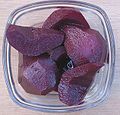Pear
| Pear | |
|---|---|
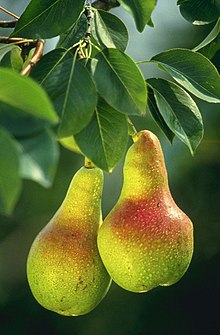
| |
| European pearbranch with two pears | |
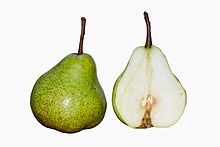
| |
| Pear fruit cross section | |
| Scientific classification | |
| Kingdom: | Plantae |
| Clade: | Tracheophytes |
| Clade: | Angiosperms |
| Clade: | Eudicots |
| Clade: | Rosids |
| Order: | Rosales |
| Family: | Rosaceae |
| Subfamily: | Amygdaloideae |
| Tribe: | Maleae |
| Subtribe: | Malinae |
| Genus: | Pyrus L. |
| Species | |
|
About 30 species; seetext | |
Pearsare fruits produced and consumed around the world, growing on a tree and harvested in late summer into mid-autumn. The pear tree and shrub are aspeciesofgenusPyrus/ˈpaɪrəs/,in thefamilyRosaceae,bearing thepomaceousfruit of the same name. Several species of pears are valued for their edible fruit and juices, while others are cultivated as trees.
The tree is medium-sized and native to coastal and mildly temperate regions of Europe, North Africa, and Asia. Pear wood is one of the preferred materials in the manufacture of high-qualitywoodwind instrumentsandfurniture.
About 3,000 known varieties of pears are grown worldwide, which vary in both shape and taste. The fruit is consumed fresh,canned,asjuice,dried,orfermentedasperry.
Etymology
[edit]The wordpearis probably from Germanicperaas aloanwordofVulgar Latinpira,the plural ofpirum,akin to Greekapios(from Mycenaeanápisos),[1]of Semitic origin (pirâ), meaning "fruit". The adjectivepyriformorpiriformmeans pear-shaped.[2]The classical Latin word for a pear tree ispirus;[3]pyrusis an alternate form of this word sometimes used inmedieval Latin.[4]
Description
[edit]

The pear isnativeto coastal, temperate, and mountainous regions of theOld World,from Western Europe and North Africa east across Asia.[5][6]They are medium-sized trees, reaching up to 20 m tall, often with a tall, narrow crown; a few pear species areshrubby.[7][8]
Theleavesare alternately arranged, simple,2–12 cm (1–4+1⁄2in) long, glossy green on some species, densely silvery-hairy in some others; leaf shape varies from broad oval to narrow lanceolate.[8]Most pears aredeciduous,but one or two species in Southeast Asia areevergreen.[8][9]Some pears are cold-hardy, withstanding temperatures as low as −25 to −40 °C (−13 to −40 °F) in winter, but many grown for agriculture are vulnerable to cold damage.[5][10]Evergreen species only tolerate temperatures down to about −12 °C (10 °F).[11]
Theflowersare white, rarely tinted yellow or pink,2–4 centimetres (1–1+1⁄2in) diameter, and have fivepetals,fivesepals,and numerousstamens.[8][12]Like that of the relatedapple,the pear fruit is apome,in most wild species1–4 cm (1⁄2–1+1⁄2in) diameter, but in some cultivated forms up to 18 cm (7 in) long and9 cm (3+1⁄2in) broad.[8]The shape varies in most species from oblate or globose, to the classic pyriform "pear shape"of theEuropean pearwith an elongated basal portion and a bulbous end.[10]
The fruit is apseudofruitcomposed of the receptacle or upper end of the flower stalk (the so-calledcalyxtube) greatly dilated.[8]Enclosed within its cellular flesh is the true fruit: 2–5 'cartilaginous'carpels,[5][13]known colloquially as the "core".[8]

Pears and apples cannot always be distinguished by the form of the fruit;[14]some pears look very much like some apples, e.g. thenashi pear.[7][15]
History
[edit]
Pear cultivationintemperate climatesextends to the remotest antiquity, and evidence exists of its use as a food since prehistoric times. Many traces have been found inprehistoric pile dwellings around Lake Zurich.[16]Pears were cultivated in China as early as 2000 BC.[17]An article on Pear tree cultivation inSpainis brought down inIbn al-'Awwam's 12th-century agricultural work,Book on Agriculture.[18]
The wordpear,or its equivalent, occurs in all theCeltic languages,while in Slavic and other dialects, differing appellations still referring to the same thing are found—a diversity and multiplicity ofnomenclature,which ledAlphonse Pyramus de Candolleto infer a very ancient cultivation of the tree from the shores of the Caspian to those of the Atlantic.[19]
The pear was also cultivated by the Romans, who ate the fruits raw or cooked, just like apples.[20]Pliny'sNatural Historyrecommended stewing them withhoneyand noted three dozen varieties. The Roman cookbookDe re coquinariahas a recipe for a spiced, stewed-pearpatina,orsoufflé.[21]Romans also introduced the fruit to Britain.[22]
Pyrus nivalis,which has white down on theundersurfaceof the leaves, is chiefly used in Europe in the manufacture ofperry(see alsocider).[19][23][24]Other small-fruited pears, distinguished by their early ripening and globose fruit, may be referred to asP. cordata,a species found wild in southwestern Europe.[25][26][27]
Thegenusis thought to have originated in present-dayWestern China[28]in the foothills of theTian Shan,a mountain range of Central Asia, and to have spread to the north and south along mountain chains, evolving into a diverse group of over 20 widely recognized primary species.[9]The enormous number of varieties of the cultivated European pear (Pyrus communissubsp.communis), are likely derived from one or two wildsubspecies(P. c.subsp.pyrasterandP. c.subsp.caucasica), widely distributed throughout Europe, and sometimes forming part of the natural vegetation of the forests.[5][8]Court accounts ofHenry III of Englandrecord pears shipped from La Rochelle-Normande and presented to the king by the sheriffs of the City of London.[29]The French names of pears grown in English medieval gardens suggest that their reputation, at the least, was French; a favoured variety in the accounts was named for SaintRieul of Senlis,Bishop ofSenlisin northern France.[30]
Asian species with medium to large edible fruit includeP. pyrifolia,P. ussuriensis,P. × bretschneideri,andP. × sinkiangensis.[8]Small-fruited species, such asPyrus calleryana,may be used asrootstocksfor the cultivated forms.[5][31]
Major species
[edit]
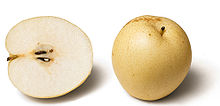
|
Cultivation
[edit]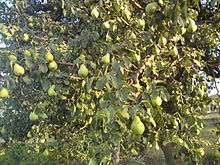
According to Pear Bureau Northwest, about 3,000 known varieties of pears are grown worldwide.[32]The pear is normally propagated bygraftinga selected variety onto arootstock,which may be of a pear orquincevariety. Quince rootstocks produce smaller trees, which is often desirable in commercial orchards or domestic gardens. For new varieties the flowers can becross-bredto preserve or combine desirable traits. The fruit of the pear is produced on spurs, which appear on shoots more than one year old.[33]
There are four species which are primarily grown for edible fruit production: theEuropean pearPyrus communissubsp.communiscultivated mainly in Europe and North America, the Chinese white pear (bai li)Pyrus × bretschneideri,the Chinese pearPyrus ussuriensis,and theNashi pearPyrus pyrifolia(also known as Asian pear or apple pear), which are grown mainly in eastern Asia.[5]There are thousands ofcultivarsof these three species.[32]A species grown in western China,P. sinkiangensis,andP. pashia,grown in southern China and south Asia, are also produced to a lesser degree.[5][8]
Other species are used asrootstocksfor European and Asian pears and asornamental trees.[5][31]Pear wood is close-grained and has been used as a specialized timber for fine furniture and making the blocks forwoodcuts.[34][35]The Manchurian or Ussurian Pear,Pyrus ussuriensis(which producesunpalatablefruit primarily used for canning) has been crossed withPyrus communisto breed hardier pear cultivars.[36]The Bradford pear (Pyrus calleryana'Bradford') is widespread as an ornamental tree in North America, where it has becomeinvasivein regions.[37][38][39]It is also used as a blight-resistant rootstock forPyrus communisfruit orchards.[36][37]The Willow-leaved pear (Pyrus salicifolia) is grown for its silvery leaves, flowers, and its "weeping" form.[5][40]
Cultivars
[edit]The followingcultivarshave gained theRoyal Horticultural Society'sAward of Garden Merit:[41]
- 'Beth'[42]
- 'Beurré Hardy'[43]
- 'Beurré Superfin'[44]
- 'Concorde'[45]
- 'Conference'[46]
- 'Doyenné du Comice'[47]
- 'Joséphine de Malines'[48]
The purely decorative cultivarP. salicifolia'Pendula', with pendulous branches and silvery leaves, has also won the award.[49]
Harvest
[edit]Summer and autumncultivarsofPyrus communis,beingclimacteric fruits,are gathered before they are fully ripe, while they are still green, but snap off when lifted.[8][50]Certain other pears, includingPyrus pyrifoliaandP. × bretschneideri,have both climacteric and non-climacteric varieties.[5][51][52]
Diseases and pests
[edit]| Country | (Millions of tonnes) |
|---|---|
| 19.3 | |
| 0.58 | |
| 0.57 | |
| 0.55 | |
| 0.52 | |
| World | 26.3 |
| Source:FAOSTAT[53] | |
Production
[edit]In 2022, world production of pears was 26 milliontonnes,led byChinawith 73% of the total (table).[53]About 48% of theSouthern Hemisphere's pears are produced in thePatagonianvalley ofRío Negroin Argentina.[54]
Storage
[edit]Pears may be stored at room temperature until ripe.[55]Pears are ripe when the flesh around the stem gives to gentle pressure.[55]Ripe pears are optimally stored refrigerated, uncovered in a single layer, where they have a shelf life of 2 to 3 days.[55]
Pears ripen at room temperature. Ripening is accelerated by the gasethylene.[56]If pears are placed next tobananasin a fruit bowl, the ethylene emitted by the banana causes the pears to ripen.[57]Refrigeration will slow further ripening. According to Pear Bureau Northwest, most varieties show little color change as they ripen (though the skin on Bartlett pears changes from green to yellow as they ripen).[58]
Uses
[edit]Cooking
[edit]
Pears are consumed fresh, canned, asjuice,anddried.The juice can also be used injelliesandjams,usually in combination with other fruits, including berries. Fermented pear juice is calledperryor pear cider and is made in a way that is similar to howcideris made from apples.[5][10]Perry can be distilled to produce aneau de viede poire,a colorless, unsweetened fruit brandy.[59]
Pear purée is used to manufacture snack foods such asFruit by the FootandFruit Roll-Ups.[60][61][62]
The culinary or cooking pear is green but dry and hard, and only edible after several hours of cooking. Two Dutch cultivars areGieser Wildeman(a sweet variety) andSaint Remy(slightly sour).[63]
Timber
[edit]Pear wood is one of the preferred materials in the manufacture of high-qualitywoodwindinstruments andfurniture,and was used for making the carved blocks forwoodcuts.It is also used for wood carving, and as afirewoodto produce aromatic smoke for smoking meat ortobacco.Pear wood is valued for kitchen spoons, scoops and stirrers, as it does not contaminate food with color, flavor or smell, and resists warping and splintering despite repeated soaking and drying cycles. Lincoln[64]describes it as "a fairly tough, very stable wood... (used for) carving... brushbacks, umbrella handles, measuring instruments such as set squares and T-squares... recorders... violin and guitar fingerboards and piano keys... decorative veneering." Pearwood is the favored wood for architect's rulers because it does not warp. It is similar to the wood of its relative, the apple tree (Malus domestica) and used for many of the same purposes.[64]
Nutrition
[edit]| Nutritional value per 100 g (3.5 oz) | |||||||||||||||||||||||||||||||||||||||||||||||||
|---|---|---|---|---|---|---|---|---|---|---|---|---|---|---|---|---|---|---|---|---|---|---|---|---|---|---|---|---|---|---|---|---|---|---|---|---|---|---|---|---|---|---|---|---|---|---|---|---|---|
| Energy | 239 kJ (57 kcal) | ||||||||||||||||||||||||||||||||||||||||||||||||
15.23 g | |||||||||||||||||||||||||||||||||||||||||||||||||
| Sugars | 9.75 g | ||||||||||||||||||||||||||||||||||||||||||||||||
| Dietary fiber | 3.1 g | ||||||||||||||||||||||||||||||||||||||||||||||||
0.14 g | |||||||||||||||||||||||||||||||||||||||||||||||||
0.36 g | |||||||||||||||||||||||||||||||||||||||||||||||||
| |||||||||||||||||||||||||||||||||||||||||||||||||
| Other constituents | Quantity | ||||||||||||||||||||||||||||||||||||||||||||||||
| Water | 84 g | ||||||||||||||||||||||||||||||||||||||||||||||||
| †Percentages estimated usingUS recommendationsfor adults,[65]except for potassium, which is estimated based on expert recommendation fromthe National Academies.[66] | |||||||||||||||||||||||||||||||||||||||||||||||||
Raw pear is 84% water, 15%carbohydratesand contains negligibleproteinandfat(table). In a100 g (3+1⁄2oz) reference amount, raw pear supplies 239 kilojoules (57 kilocalories) offood energy,a moderate amount ofdietary fiber,and nomicronutrientsin significant amounts (table).
Research
[edit]A 2019 review found preliminary evidence for the potential of pear consumption to favorably affect cardiovascular health.[67]
Cultural references
[edit]Pears grow in the sublimeorchardofAlcinous,in theOdysseyvii: "Therein grow trees, tall and luxuriant, pears andpomegranatesandapple-trees with their bright fruit, and sweetfigs,and luxuriantolives.Of these the fruit perishes not nor fails inwinteror in summer, but lasts throughout the year. "[68]
"APartridgein a Pear Tree "is the first gift in thecumulative song"The Twelve Days of Christmas".[69]
The pear tree was an object of particular veneration (as was thewalnut) in thetree worshipof theNakh peoplesof theNorth Caucasus– seeVainakh mythologyand see alsoIngushetia– the best-known of the Vainakh peoples today being theChechensofChechnya.Pear and walnut trees were held to be the sacred abodes of beneficent spirits in pre-Islamic Chechen religion and, for this reason, it was forbidden to fell them.[70]
Gallery
[edit]-
Pears simmered in red wine
-
Pear in a bottle of peareau de vie
-
Pear blossom in eastern Siberia
See also
[edit]References
[edit]- ^Harper, Douglas."pear".Online Etymology Dictionary.
- ^"pyriform, adj".Oxford English Dictionary.Oxford University Press.Retrieved28 April2021.
- ^Lewis, Charlton T.; Short, Charles (1879)."pĭrus".A Latin Dictionary.Clarendon Press. Archived fromthe originalon 15 May 2022 – via thePerseus Project.
- ^Charles du Fresne, sieur du Cange."PYRUS".Glossarium Mediae et Infimae Latinitatis.Archived fromthe originalon 15 May 2022 – viaLogeion.
- ^abcdefghijkBell, Richard L.; Itai, Akihiro (2011), Kole, Chittaranjan (ed.),"Pyrus",Wild Crop Relatives: Genomic and Breeding Resources,Berlin, Heidelberg: Springer Berlin Heidelberg, pp. 147–177,doi:10.1007/978-3-642-16057-8_8,ISBN978-3-642-16056-1,retrieved7 June2024
- ^Janick, Jules; Moore, James N., eds. (1996).Fruit breeding.New York: Wiley.ISBN978-0-471-12675-1.
- ^ab"Pyrus communis - Plant Finder".missouribotanicalgarden.org.Retrieved7 June2024.
- ^abcdefghijkQuinet, Muriel; Wesel, Jean-Pierre (2019), Korban, Schuyler S. (ed.),"Botany and Taxonomy of Pear",The Pear Genome,Cham: Springer International Publishing, pp. 1–33,doi:10.1007/978-3-030-11048-2_1,ISBN978-3-030-11048-2,retrieved7 June2024
- ^abRubtsov, G. A. (July 1944)."Geographical Distribution of the Genus Pyrus and Trends and Factors in Its Evolution".The American Naturalist.78(777): 358–366.doi:10.1086/281206.ISSN0003-0147.
- ^abcHedrick, U.P.; Howe, G.H.; Taylor, O.M.; Frances, E.H.; Tukey, H.B. (1921).The Pears of New York.Albany: J. B. Lyon Co.
- ^"Evergreen Pear - SelecTree: A Tree Selection Guide".selectree.calpoly.edu.Archived fromthe originalon 18 April 2024.Retrieved7 June2024.
- ^Pear Fruit Facts Page Information.bouquetoffruits
- ^"Pyrus in Flora of North America @ efloras.org".efloras.org.Retrieved7 June2024.
- ^The New Werner Twentieth Century Edition of the Encyclopaedia Britannica: A Standard Work of Reference in Art, Literature, Science, History, Geography, Commerce, Biography, Discovery and Invention.Werner Company. 1907. p.456.
- ^Nelson, John."Spring blooming Asian pear looks much like an apple | Mystery Plant".Tallahassee Democrat.Retrieved7 June2024.
- ^Antolín, Ferran; Bleicher, Niels; Brombacher, Christoph; Kühn, Marlu; Steiner, Bigna L.; Jacomet, Stefanie (6 June 2016)."Quantitative approximation to large-seeded wild fruit use in a late Neolithic lake dwelling: New results from the case study of layer 13 of Parkhaus Opéra in Zürich (Central Switzerland)".Quaternary International.Archaeobotany of wild plant use: Approaches to the exploitation of wild plant resources in the past and its social implications.404:56–68.doi:10.1016/j.quaint.2015.08.003.ISSN1040-6182.
- ^Clement, Charles R. (2005). Prance, Ghillean; Nesbitt, Mark (eds.).The Cultural History of Plants.Routledge. p. 86.ISBN0415927463.
- ^Ibn al-'Awwam, Yaḥyá(1864).Le livre de l'agriculture d'Ibn-al-Awam (kitab-al-felahah)(in French). Translated by J.-J. Clement-Mullet. Paris: A. Franck. pp. 240–242 (ch. 7 - Article 12).OCLC780050566.(pp.240–242 (Article XII)
- ^abde Candolle, Alphonse (1908).The Origin of Cultivated Plants: The International Scientific Series Volume XLVIII.New York: D. Appleton and Company.
- ^Toussaint-Samat, Maguelonne (2009).A History of Food.John Wiley & Sons. p. 573.ISBN978-1-4443-0514-2.
- ^Grainger, Sally & Grocock, Christopher (2006).Apicius (with an introd. and an Engl. transl.).Blackawton, Totnes: Prospect Books. p. IV.2.35.ISBN978-1-903018-13-2.
- ^Lyle, Katie Letcher (2010) [2004].The Complete Guide to Edible Wild Plants, Mushrooms, Fruits, and Nuts: How to Find, Identify, and Cook Them(2nd ed.). Guilford, CN:FalconGuides.p. 105.ISBN978-1-59921-887-8.OCLC560560606.
- ^Kole, Chittaranjan; Kole, Chittaranjan (2011).Wild Crop Relatives: Genomic and Breeding Resources Temperate Fruits.Biomedical and Life Sciences (Springer-11642). Berlin, Heidelberg: Springer Berlin Heidelberg Springer e-books.ISBN978-3-642-16057-8.
- ^Itai, A. (2007), Kole, Chittaranjan (ed.),"Pear",Fruits and Nuts,vol. 4, Berlin, Heidelberg: Springer Berlin Heidelberg, pp. 157–170,doi:10.1007/978-3-540-34533-6_6,ISBN978-3-540-34531-2,retrieved8 June2024
- ^Aldasoro, J. J.; Aedo, C.; Garmendia, F. MuñOz (28 June 2008)."The genus Pyrus L. (Rosaceae) in south-west Europe and North Africa".Botanical Journal of the Linnean Society.121(2): 143–158.doi:10.1111/j.1095-8339.1996.tb00749.x.
- ^AYDIN, ZÜBEYDE; DÖNMEZ, ALİ (1 January 2015)."Taxonomic and nomenclatural contributions to Pyrus L. (Rosaceae) from Turkey".Turkish Journal of Botany.39(5): 841–849.doi:10.3906/bot-1411-34.ISSN1300-008X.
- ^"Pyrus cordata | Plymouth pear Trees/RHS Gardening".rhs.org.uk.Archived fromthe originalon 8 June 2024.Retrieved8 June2024.
- ^Silva, G. J.; Souza, Tatiane Medeiros; Barbieri, Rosa Lía; Costa de Oliveira, Antonio (2014)."Origin, Domestication, and Dispersing of Pear ( Pyrus spp.)"(PDF).Advances in Agriculture.2014:1–8.doi:10.1155/2014/541097.ISSN2356-654X.
- ^Amherst, Alicia (1895).A History of Gardening in England by the Hon. Alicia (M.T.) Amherst...B. Quaritch.
- ^Cecil, Evelyn (2006).A History of Gardening in England.Kessinger Publishing. pp. 35 ff.ISBN978-1-4286-3680-4.
- ^ab"Rootstocks for Pear | WSU Tree Fruit | Washington State University".Retrieved8 June2024.
- ^ab"Pear Varieties".Usapears. Archived fromthe originalon 25 June 2014.Retrieved9 August2014.
- ^RHS Fruit, Harry Baker,ISBN1-85732-905-8,pp100-101.
- ^"Pear | The Wood Database (Hardwood)".Archived fromthe originalon 24 March 2024.Retrieved8 June2024.
- ^"Woodcut".The Metropolitan Museum of Art.8 June 2024. Archived fromthe originalon 15 May 2024.Retrieved8 June2024.
- ^abBell, Richard L. (2019), Korban, Schuyler S. (ed.),"Genetics, Genomics, and Breeding for Fire Blight Resistance in Pear",The Pear Genome,Cham: Springer International Publishing, pp. 243–264,doi:10.1007/978-3-030-11048-2_13,ISBN978-3-030-11047-5,retrieved8 June2024
- ^abCulley, Theresa M.; Hardiman, Nicole A. (1 December 2007)."The Beginning of a New Invasive Plant: A History of the Ornamental Callery Pear in the United States".BioScience.57(11): 956–964.doi:10.1641/b571108.ISSN1525-3244.
- ^Vincent, Michael A. (1 March 2005)."On the Spread and Current Distribution of Pyrus calleryana in the United States".Castanea.70(1): 20–31.doi:10.2179/0008-7475(2005)070[0020:OTSACD]2.0.CO;2.ISSN0008-7475.
- ^Owen, Luke (27 March 2024)."Bradford Pear: An Invasive Pest".buncombe.ces.ncsu.edu.Archived fromthe originalon 29 May 2024.Retrieved8 June2024.
- ^"Pyrus salicifolia 'Pendula' - Plant Finder".missouribotanicalgarden.org.Archived fromthe originalon 8 June 2024.Retrieved8 June2024.
- ^"AGM Plants"(PDF).
- ^"RHS Plant Selector Pyrus communis 'Beth' (D) AGM / RHS Gardening".Apps.rhs.org.uk.Retrieved17 February2021.
- ^"RHS Plantfinder -Pyrus communis'Beurré Hardy'".Retrieved23 September2018.
- ^"RHS Plantfinder -Pyrus communis'Beurré Superfin'".Retrieved23 September2018.
- ^"RHS Plant Selector Pyrus communis 'Concorde' PBR (D) AGM / RHS Gardening".Apps.rhs.org.uk.Retrieved17 February2021.
- ^"RHS Plant Selector Pyrus communis 'Conference' (D) AGM / RHS Gardening".Apps.rhs.org.uk.Retrieved17 February2021.
- ^"RHS Plantfinder -Pyrus communis'Doyenné du Comice'".Retrieved23 September2018.
- ^"RHS Plant Selector Pyrus communis 'Joséphine de Malines' (D) AGM / RHS Gardening".Apps.rhs.org.uk.Retrieved17 February2021.
- ^"RHS Plantfinder -Pyrus salicifolia'Pendula'".Retrieved23 September2018.
- ^Marini, Richard P. (2009)."Growing Pears in Virginia".Virginia Cooperative Extension.Publication 422-017. Archived fromthe originalon 8 June 2024.
- ^Itai, Akihiro; Fujita, Naoko (February 2008)."Identification of Climacteric and Nonclimacteric Phenotypes of Asian Pear Cultivars by CAPS Analysis of 1-Aminocyclopropane-1-Carboxylate Synthase Genes".HortScience.43(1): 119–121.doi:10.21273/HORTSCI.43.1.119.ISSN0018-5345.
- ^Korban, Schuyler S., ed. (2019).The pear genome.Compendium of plant genomes. Cham: Springer.ISBN978-3-030-11047-5.
- ^ab"Production of pears in 2022, Crops/Regions/World Regions/Production Quantity/Year by picklists".UN Food and Agriculture Organization, Statistics Division. 2024.Retrieved30 March2024.
- ^"Las peras de Río Negro convierten al país en el segundo exportador a nivel mundial".Registro Civil(in Spanish). 31 January 2020.Retrieved29 November2022.
- ^abcCanadian Produce Marketing Association > Home Storage Guide for Fresh Fruits & Vegetables.cpma.ca
- ^Himmelblau, David M.; Riggs, James B. (2022).Basic principles and calculations in chemical engineering.International series in the physical and chemical engineering sciences (Ninth ed.). Boston: Pearson.ISBN978-0-13-732717-1.
- ^Scott, Judy & Sugar, David (2011)."Pears can be ripened to perfection".extension.oregonstate.edu.Retrieved30 August2011.
- ^"Pear Bureau Northwest".Usapears.org. Archived fromthe originalon 10 May 2013.Retrieved14 March2013.
- ^Stewart, Amy (2013).The drunken botanist: the plants that create the world's great drinks.A New York Times bestseller. Chapel Hill, N.C: Algonquin Books of Chapel Hill.ISBN978-1-61620-046-6.
- ^"Global and Japan Pear Puree Market Analysis 2022: Industry Size, Share, Emerging Trends, Growth Opportunities And Forecast To 2028".stratagemmarketinsights.Archived fromthe originalon 9 June 2024.Retrieved9 June2024.
- ^"EWG's Food Scores: Fruit by the Foot Fruit Flavored Snacks, Strawberry, Strawberry".ewg.org.Archived fromthe originalon 20 May 2022.Retrieved9 June2024.
- ^"EWG's Food Scores: Fruit Roll Ups Blue Raspberry, Berry Punch Fruit Flavored Sour Snacks, Blue Raspberry, Berry Punch".ewg.org.Archived fromthe originalon 27 March 2023.Retrieved9 June2024.
- ^Koene, A. (2005).Food Shopper's Guide to Holland: A Comprehensive Review of the Finest Local and International Food Products in the Dutch Marketplace.Eburon Uitgeverij B.V. p.79.ISBN978-90-5972-092-3.
- ^abLincoln, William (1986).World Woods in Color.Fresno, California, USA: Linden Publishing Co. Inc. pp. 33, 207.ISBN0-941936-20-1.
- ^United States Food and Drug Administration(2024)."Daily Value on the Nutrition and Supplement Facts Labels".FDA.Archivedfrom the original on 27 March 2024.Retrieved28 March2024.
- ^National Academies of Sciences, Engineering, and Medicine; Health and Medicine Division; Food and Nutrition Board; Committee to Review the Dietary Reference Intakes for Sodium and Potassium (2019). Oria, Maria; Harrison, Meghan; Stallings, Virginia A. (eds.).Dietary Reference Intakes for Sodium and Potassium.The National Academies Collection: Reports funded by National Institutes of Health. Washington, DC: National Academies Press (US).ISBN978-0-309-48834-1.PMID30844154.Archivedfrom the original on 9 May 2024.Retrieved21 June2024.
- ^Gayer BA, Avendano EE, Edelson E, et al. (2019)."Effects of Intake of Apples, Pears, or Their Products on Cardiometabolic Risk Factors and Clinical Outcomes: A Systematic Review and Meta-Analysis".Current Developments in Nutrition.3(10): nzz109.doi:10.1093/cdn/nzz109.PMC6813372.PMID31667463.
- ^Homer (1975) [Composed 8th century BCE].The Odyssey of Homer.Translated by Lattimore, Richmond. New York: Harper & Row.ISBN9780060904791.
- ^Bodleian Libraries, University of Oxford."The twelve days of Christmas".Broadside Ballads Online.Retrieved4 December2023.
- ^The Chechens: A Handbookby Jaimoukha, Amjad. Published by Psychology Press, 2005.ISBN978-0-415-32328-4.
Further reading
[edit]- Joan Morgan (2015).The Book of Pears: The Definitive History and Guide to Over 500 Varieties.Chelsea Green Publishing.ISBN978-1603586665.

